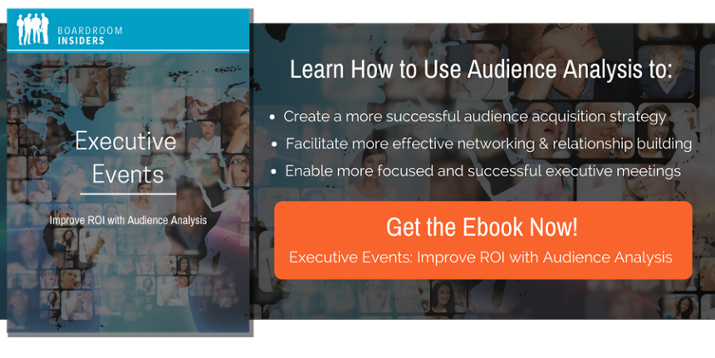.png?width=700&height=400&name=Attention%20Technology%20Marketers-%20(16).png)
As a savvy marketer, you have probably noticed that digital “transformation” has risen to the top of most CEO agendas. And as a result, you’re probably being challenged by your leadership to provide more content and communications that are relevant and engaging with C-Level executives.
But what does “C-Level executive relevant” mean?
- It means focusing on business outcomes as opposed to products and solutions.
If the company is focused on cost cutting and operational efficiency, focus your conversation apporpriately. On the other hand, if innovation and growth is their focus, you should use those terms to structure your conversation.
- It means having a relevant ROI story.
If your solution enables automation of specific tasks, quantify the cost savings in terms of actual man hours.
- It means having credible customer success stories.
Ideally you have a story from their own industry that focuses on both business outcomes and ROI. If not, choose a success story that most closely tracks to the business outcome they are trying to achieve -- See above bullet points.
- And finally, it means understanding each individual C-Level executive's business issues and being able to connect the dots back to your own products, services and solutions.
If a CIO says she wants to spend 80% of her technology budget on initiatives that drive personalization, frame your solution in terms of how it specifically helps drive personalization.
.png?width=200&name=You%20must%20change%20corng%20(1).png) For marketing organizations that are increasingly relying on automated technology, inbound marketing tools, and social selling, this represents a real challenge. Because C-Level executives generally ignore automated emails, and don’t spend a lot of time on social media. They live in a world where:
For marketing organizations that are increasingly relying on automated technology, inbound marketing tools, and social selling, this represents a real challenge. Because C-Level executives generally ignore automated emails, and don’t spend a lot of time on social media. They live in a world where:
- They buy business outcomes, not products.
- People buy from people and relationships matter.
Which means as a marketer, you have to change course from a “one-to-many” approach to “one to one.”
Supporting the New C-Level Executive Selling Mandate
Our marketer customers are getting creative in how they approach C-Suite engagement to support this type of selling effort. And, because scalability is a concern, they are taking a program-like approach to their C-Level executive engagement efforts--or as much as you can anyway, with something that is, by nature, one-to-one.
Here are five ways marketers can support their sales colleagues as they embark on a C-suite selling effort:
1. Collaboration around Big Deals
Marketing can provide sales with content and tools to help “swarm” an account when a huge deal is on the table. Our customer DXC Technology (formerly known as CSC) calls it “Pursuit Marketing."
"If you think about ABM as a multi-layered pyramid, with each layer targeting a decreasing number of accounts with more spedcific marketing activities, Pursuit Marketing is at the very tip of that triangle. It focuses on a small number of strategically important accounts at a very specific point in their journey with CSC. The goal is to surround the buying center with messaging that is highly relevant, is 100% in line with the company's goals and will thus resonate with the decision makers and influencers." -Dorothea Gosling, DXC Technology
Pursuit Marketing is a hyper-targeted one-to-one type of activity -- and it requires deeper intelligence on the company, the decision makers and influencers so that you can customize your message for them so that it resonates and is aligned with whatever their objectives are.
2. Research & Insight on C-Level Executives
Read any sales and marketing publication and you’re bound to be lectured on the importance of knowing your customer. Knowing your customer can mean different things, but when it comes to big-ticket enterprise sales, we believe it boils down to understanding who they are as individuals, what they do, their business strategy and goals, and the obstacles that stand in the way of their success.
When you consider the number of decision makers and the number of companies you need to track, collecting and updating this information on a regular basis can be overwhelming.
Go beyond LinkedIn and read the company’s latest earnings call transcript on SeekingAlpha to get a good high-level view of what company management is focused on. And Google your contact’s boss to see if you can find any interviews with them and discern what they care about.
3. Executive-to-Executive Relationship Mapping
Want to know how your executives are connected to your C-Level customers? Make a list of organizations your contact is connected to (like the US Navy as in the following example), and find out if any of your senior executives have a similar connection.
.png?width=500&name=boardroom%20insiders%20(3).png)
4. Thought Leadership Content
Most companies already do a pretty good job producing relevant thought leadership content. But they need to do a better job at telling the C-Suite why the content is relevant to their business. For example, don’t rely on automated emails to promote thought leadership that should be of interest to your contacts; send a personal email pointing them to the content and telling them why you think it should be of interest. (e.g., Joe, this is a great article that dives deeper into what you were talking about in your recent interview with Business Insider…”)
5. C-Level Engagement Programs
Customer advisory boards, executive sponsorship programs, executive briefing centers and C-Level executive events and sponsorships are all good ways to secure executive-to-executive face time. If you have ever been involved in these types of programs you know that when it comes to busy executives, you better give them a very good--and a very relevant--reason to engage in these programs. Generic, vague invitations don’t work--make sure you personalize your invitation by connecting the dots between your invitation and one or more of their business initiatives--and ideally, have the invitation come from one of your senior executive leaders.
Don’t let your sales team founder in ignorance as they reach out to today’s real tech decision makers. As a marketer, you have the power to partner with your team and deliver C-Level executive insights and programs that will get them in the door and closer bigger deals, faster.







Share Your Thoughts